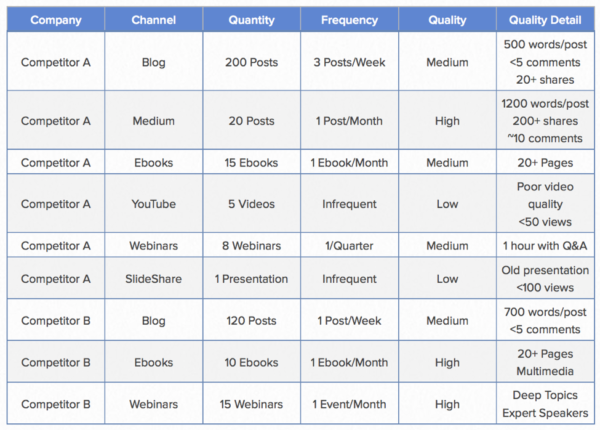If you're using content marketing, then so are your competitors.
And that's not just people who compete with you directly, by offering similar products or services.
This can also include people with whom you're competing not for the audience's pocketbooks, per se, but for their attention.
So one of these days, you're going to need to sit down and analyze what these other parties are doing with content.
What's their strategy? Is it working?
If so, what can you emulate? If not, what exactly are they doing wrong?
This can be a little time consuming, but it's worth it.
In a recent blog post, The Content Marketing Institute offers a step by step process that you can use to gather and analyze quantitative information about your competitors' use of blog content, videos, and more.
Here's how you can get a handle on what they're doing:
To do a competitive content marketing analysis, take a list of your content marketing competitors and follow these three steps:
- Take inventory of your competitors’ content
- Evaluate content quantity and quality
- Tag and analyze content topics.
Step 1: Take inventory of your competitors’ content
Catalog each content medium and each content site.
- Blog articles: Frequently published, short-form content gives insight into the range and relative importance of content topics and keywords.
- Podcast and audio recordings:Audio content can add color to how the team operates and thinks about certain topics.
- Webinars: Past and upcoming webinars will often go deeper into a topic of particular interest to the audience.
- E-books and white papers: From top-of-the-funnel e-books to deeper-dive white papers or research reports, long-form written content highlights key target topics.
- Videos:Visual content can give you a more thorough look into a company’s brand and tone.
- Presentations: Whether SlideShare posts or another format, presentations are rich with thought leadership and product content.
- E-newsletters:Emails reveal what content companies think is most valuable to send directly to their prospects and customers.
Step 2: Evaluate content quantity and quality
Look for trends in engagement level – shares, comments, etc. – to understand how well the content is performing.
[image source: The Content Marketing Institute]
Step 3: Tag and analyze content topics
Tagging and analyzing the topics of each content piece helps surface content marketing gaps, which become opportunities for you.
As you review each piece, take note of the content’s title and description, and consume as much of the content as feasible.
[image source: The Content Marketing Institute]
Habit of intel-driven content
To make sure your content remains differentiated, it’s important to build a habit around seeking and leveraging intel on your competitors’ content strategies.
On top of that, you will likely find that you have content competitors – organizations who compete with you for your audience’s attention who don’t necessarily have competitive products or services.
Analyzing the content marketing landscape can be a time-consuming but critical step in creating unique content that truly stands out among the noise.
You can read more about how to analyze your competitors' content strategies in the full article from The Content Marketing Institute.
CHALLENGE Yourself to Profit!
Free Download: Build Your Profit-Generating Online Business With This Free Blueprint
Sign Up, follow the easy steps and You'll get the tactics, strategies & techniques needed to create your online profit stream. It's free!





